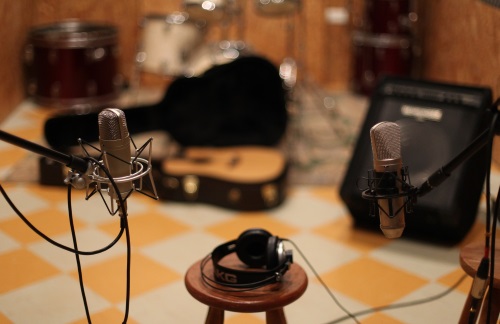
Room Mics
It’s a major commitment to mix the room mics into the drum mix. Back in the day of 4 and 8-track machines, I used to record 2-track drums: kick on one track and everything on the other track.
Later, with 16-track, stereo drums required three tracks: left and right and the kick and using a separate snare track was a luxury. I would mix the close mics along with the overs to the stereo tracks using pan pots that matched the actual physical position of the overhead mics over the kit. If I used room mics, they would also go into those stereo tracks.
Looking at the drummer from the audience’s perspective, the right overhead is over the hi-hat side (assuming a right-handed drummer) and I’ll add in the close hi-hat mic panned mid-right. I use audience perspective when monitoring and most drummers like to hear themselves in drummer’s perspective which I provide in their headphones… or they can just wear the phones backwards.
Nowadays, unless you have a great sounding room and most of the drum sound comes from room mics, John Bonham style, you should record those mics on extra tracks. If you like to compress the room mics or the overheads, do it while recording…commit to that process.
Compressors react much better and differently to live sound mic sources than already recorded tracks. If you are unsure of what you have, record it with and without compression at the same time and later, erase the tracks you don’t need.
Headphone Mixes
Headphones and their mix always seems to be a major source of complaint. When recording a drummer, two guitar players, bass, keyboard and a singer, you’ll probably need more than one headphone mix and cue system. When recording one musician at a time, you’d need only one, and it can usually be the same mix you have in the control room.
Drummer Headphones
Drummers require loud headphones that firmly fit his/her head. That’s means expensive, low impedance studio headphones and a big power amp to run them.
You can get volume with a 5-watt amp and a cheap pair of phones, but you can’t get clean dynamic range and good low frequencies – the drummer will need to feel the bass instrument, the warmth of the track mix and a sense of the volume changes himself and the other musicians make.
It’s very important that the cue mix represent what each musician is playing dynamically. If you do a lot of live recording, it is worth spending money on good phones and a powerful amplifier to run them.
If you can only derive two cue mixes, one of them should be for the drummer. The mix I like to give the drummer (in order of loudness): plenty of himself so that he doesn’t play overly hard (unless you want that), a click track (if you use one) good bass and the rest of the band including just enough vocal to know where he is in the song.
I use stereo cues and try to get a spacious sound mix with subtle effects and wide panning of instruments that is hopefully inspiring. Click tracks and instruments for keeping time should be dry and mono…in the middle.
Auto Talkback Mic
Instant communication is super important during the tracking session. Close miking of amps and DI recording won’t allow you to hear normal conversation levels. If you’ve ever try using an extra microphone just to hear what your players are saying, you have to make sure you always mute it when they start playing or risk getting a loud surprise—that could do damage.
Here’s a trick for an automatic talkback mic. I use a single omnidirectional microphone placed in the center of the recording room. I use very high microphone gain and patch the pre-amp’s output through a compressor cranked all the way up (minimum threshold).
Use 20:1 ratio or higher with the fastest attack possible (1 ms or faster) and a slow release (5 seconds). Any adjustable compressor will work, but I use a Universal Audio (UA) 1176LN for this purpose and route the output to it’s own track and, of course the monitor mix and the headphones.
This compressor will nearly always be in constant gain reduction mode but when nobody is playing, compression releases, and you’ll hear the quietest sounds due to the high mic pre-amp setting. If the drummer hits his drum unexpectedly, the fast attack will grab immediately and compress completely and avoid hurting anybody’s ears.
When the band starts playing, the compressor squashes the gain of the microphone so much, it’s not heard any more in the phones or the monitor mix. Once things get quiet again, the compressor releases and you’ll hear conversation levels easily again.
I use this system as a “set and forget” auto talkback and the musicians seem to like it because they can hear themselves talking to one other without ever taking the headphones off.
